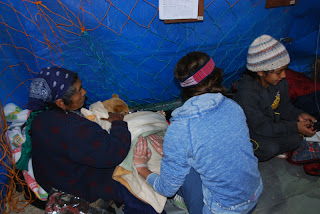COMMUNITY DAY
Saturday we put on the 2nd part of our community events. Friday was the school event. Saturday is the main market day in El Centro (with a smaller market on Wednesdays) and so we wanted to provide activities for kids and their parents. We had permission to set up some activities in the Parque Centrale. It was a beautiful sunny day and once it warmed up it was lovely. Lots of activity and the Parque was crowded. We set up outside the post office, taped up the posters the kids had drawn at the school yesterday, complete with the mistaken 'recommendation' to bathe their dogs every day!!
We had a brief announcement and a skit showing what NOT to do around strange or menacing dogs (Elena and I walking along chatting and then when seeing a strange dog, screaming and running around waving our arms vs standing quiet and still, like a tree or curling up like a rock). Then we had a lotteria (like BINGO), a bowling game, group painting and the favorite which was colouring animal masks which we would then cut out for them to wear. It was a hectic but well-received few hours.
 |
| Guillermo DJs |
The kids work hard on their masks and show them off. The brown markers were in high demand as the kids went for realism in their colouring of the horses, cows and dogs.
 |
| A little boy poses with his chicken mask |
 |
| Guillermo and a little girl in rabbit mask |
 |
| Kelleigh and Janne arrive in Todos Santos |
 |
| Natalie loads of the autoclave |
Had our 1st clinic today. Patty and her group arrived about 8 o'clock last night which was great - and a big relief. They had had a long day and a half of travel leaving Toronto Saturday night and then spending about 7 hours driving in a van up to T.S. They had an incredible amount of hassle with the autoclave. Patty had had a wooden box on wheels made for the autoclave and it was enormous and heavy. They had problems leaving Toronto (as the workers in Canada won't lift more than 70 lbs - which seems bizarre to someone working in the veterinary field where we routinely lift 80-100 lb struggling, sometimes peeing and biting dogs - and it is often women doing this lifting as the veterinary field becomes increasingly female). Finally through begging and pleading they were able to get the autoclave on the 1st plane - only to have the same problem in Houston. Finally they had the guy in charge of loading the plane come down and look to it and then he personally ensured that the autoclave made it safely on the plane. Patty's clinic, Allandale, had tested the autoclave in Barrie when it arrived and we all waited anxiously to see if it still worked upon arrival in Todos Santos. There was a slight delay as we tried to open the wooden case since the carpenter had used Robertson screws and of course there are no Robertson screwdrivers in Guatemala(note to self: travel with a Robertson tip screwdriver, just in case. We finally pried the case open with a crowbar and extracted the autoclave and - yay! - it worked!!
On Sunday, we had moved over all the supplies to the Salon Municipal and had obtained some wooden tables from the church to use as surgery and exam tables and well as some tables for setting out the supplies. We got to the Salon Municipal early on Monday morning and started to unload all the bins of supplies Patty's clinic had brought and donated to the project. We had about 12 surgeries booked for the Monday and had booked 18 a day for the following 3 days then only 10-12 on our last day. We had a lot of people on Monday:
Elena and Guillermo - project directors for VWB-VSF Canada in Chile.
Myself and Stacey Ness from the Central Victoria Veterinary Clinic in Victoria, BC
Marien from Homeless Pets Club in Atlanta, Georgia
Andrea Portillo, a vet from Ciudad de Guatemala
Heidi, a vet from Ciudad de Guatemala, looking for more surgical experience as she did mainly a housecall practice.
Kelleigh Waters, a 4th year veterinary student from the University of Prince Edward Island in Canada, who had been in T.S. for 2 months in 2011, doing surveys
Janne Robinson, from Edmonton, Albert who has done a lot of fundraising for this project and was interested in seeing it in action
Stephanie Silva, a technician from Barrie - one of our few spanish-english speakers
Patricia Lechten, owner of Allandale Veterinary Clinic in Barrie, as well as 4 of her staff:
Lindsey Rogers- a veterinarian
Melissa Payne - technican
Lynsay Durbano- RVT
Natalie Flammia - veterinary assistant
Adriana Contreras, a veterinarian from Huehuetenango (1 1/2 to 2 hours away)
Hypothermia is a big problem for surgeries in Todos Santos. Even though the weather was good, clear and sunny, up to 22oC in the day, it was very cold morning and night, and stayed cold in the salon until the sun rose enough to come in through the high windows. We'd oriented our 3 surgery tables to take advantage of this eventual light and warmth. Without surgical lights we'd brought headlights to see our surgical sites by. Stacey, ever creative, had invented and sewn together some fleece V-troughs that she could insert large plastic water or pop bottles into, and these bottles were filled with warm water to help keep the patients warm. We also used the metallic space blankets around our patients in surgery and in recovery to help keep them warm. Stacey had also brought baby socks and wrapped the surgery patients' paws in squares of 'emergency blanket' material and then pulled the baby socks over to help reduce heat loss.
This helped but hypothermia was still a problem - it seemed more of an issue this year, I believe because of the xylazine we had to use. The other drugs we used (low-dose acepromazine, ketamine and Tramadol) were all drugs we've used in previous years and had shorter recoveries and slightly less hypothermia. This year we had a lot of bradycardia (severe bradycardia) and I think this can only be from the xylazine.
We put all our patients on IV fluids and intubate them. We don't have oxygen in Todos Santos but we bring human AMBU bags and can support the patients ventilation. The surgery techs also monitor heart rate and pulse. The protocol used by the Guatemalan vets uses a very high initial intramuscular dose of xylazine and ketamine and then top up with xylazine as needed. They don't have technicians monitoring their anaesthesias and so it's more practical for them to give just one dose if possible. For the Canadian vets, we prefer to keep the anaesthesia on a plane that just keeps the patient under just enough to not feel the surgery and not to be moving but we don't want them too deep as this is riskier. We would rather have to add anaesthesia as needed during the surgery than to possibly overdose some patients.
We did find we had to use alot of anesthetic drugs to keep patients at a surgical plane, much more than we had anticipated. The anaesthesia last year, using Zoletil, Tramadol and acepromazine, was much better.
 |
| Post-op Patient - bundled up |
 |
| Marien monitors patients post-op |
 |
| Janne comforts patients and owners in Recovery |
VACCINE CLINIC
In general the animals brought in are incredibly quiet and patient, along with their owners as they wait, sometimes for a very long time. The dogs are tied by ropes, pieces of wire, and though many come from other communities and are surrounded by many other dogs from other communities, the majority of them lie at their owners' feet in the Salon municipal, quietly waiting. Occasionally you get a dog which takes exception to its situation and the other dogs and then all is cacophony and pandemonium.
This year for the 1st time we are also vaccinating cats. Ever since the 1st time I came to Todos Santos in 2009, people here have been aside when we will be doing cats. The cats brought in to us are amazing. They come in, either in feed sacks tied with twine or else in the owners arms secured by a homemade twine or soft cloth strip harness. They are waiting for sometimes a long time, in a big salon, surrounded by dogs and commotion, they often have come from a long distance as the owners walk from their community to El Centro, and they sit so quietly as patiently. I can't think of many Canadian cats that would sit so quietly, and even Andrea said her feline patients in la Ciudad de Guatemala would not be so calm and patient. The cats were invariable good to handle - amazing.
The dogs are still very skittish and it can be a huge production to get the muzzles on. We usually would put a slip lead on as the ropes and occasionally collars they come in with slip off very easily to a canny dog that knows how to back up and slip the rope off over its head. We usually get the owners to put the muzzle (bolsal) over the dog's muzzle as they panic with us, then we clip it and pick the dog up to weigh and examine. Some dogs are deceptively quiet and passive and then explode as you pick them up or as in mid-exam and start thrashing, peeing and trying to bite. They are very good with their claws and with twisting about to try and escape. We've all received some good hits in the face and head with their very hard heads and scratches on our arms.
DOÑA FLORA'S KITCHEN
Breakfast again can range from the comida typíca or chapin breakfasts to cornflakes with warm milk, pancakes, french toast, tamale (delicious and warming on a cold morning, as warming as oatmeal porridge). After several years of feeding our group she has become more creative with the vegetarian meals (not common in Todos Santos). The vegetarians are starting to rival the meat-eaters in number. Amalia was a vegan, very unusual in a Guatemalan, and tough to maintain. Out of our current 16, 6 are vegetarians, including Andrea Portillo the vet from Guatemala City.
We were all more than ready to head back to our respective hotels and head to bed by 9 PM. We were a bit spread out. Elena, Guillermo, Stacey and I had moved to 2 rooms in the Casa Familare. It's across from the Salon Municipal where we are doing our clinics, handy for laundry, bathrooms and one room has a kitchen to heat water for the hot water bottles and to run the pressure cooker autoclave Stacey brought. Patty's group are staying at El Viajero (Nosey's street), where VWb-VSF team members have stayed since 2009. The Guatemalan vets, Kelleigh, Marien and Janne are staying at the Hotelito. Some of the Canadian vets are having trouble with Todos Santos' over-enthusiastic, chronologically-challenged roosters who start crowing soon after midnight and don't stop. I remember how bothered I was by them my 1st time up here but they don't wake me up any more, nor do the packs of barking dogs, the HueHue bus at 4:30 AM honking to warn people it's leaving, not the market set up noises nor the evangelical singing and chanting. It's all just background Todos Santos noise now.














































